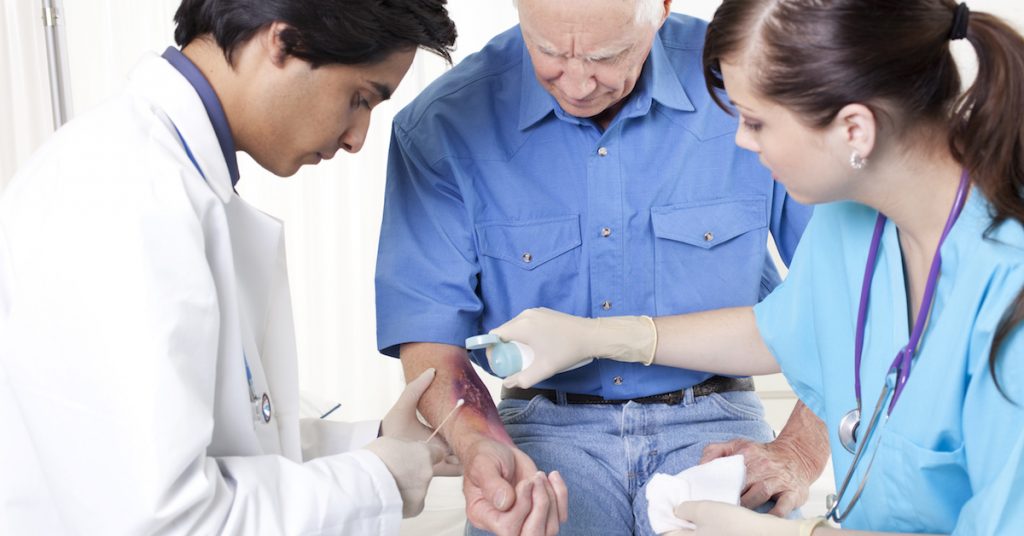
Burns are extremely common household injuries. Children, the elderly, and individuals with impaired sensation caused by diabetes or other health conditions are especially at risk. Should you suffer a burn injury, here is information to help diagnose the severity of the burn and steps that FastMed recommends you take at home for relief.
What Is the Difference Between a First vs. Second-Degree Burn?
Burns are typically classified as first, second, third, or fourth-degree based on the severity of the damage to the skin.
First-Degree Burns
First-degree burns involve the most superficial layer of the skin. Touching a hot stove or even prolonged exposure to the sun can result in a first-degree burn. Although relatively minor, first-degree burns can still be quite painful and potentially cause scarring if not treated properly.
Second-Degree Burns
Second-degree burns cause damage below the surface of the skin. It is common for the skin to become extremely red and sore and to blister. The healing time of a first vs. second-degree burn is also different. Most first-degree burns heal within seven to 10 days; however, second-degree burns may take several weeks.
Third- and Fourth-Degree Burns
Third- and fourth-degree burns are the most severe and require immediate emergency medical treatment to prevent life-threatening complications, such as infection, hypothermia, and low blood volume caused by fluid loss. Third- and fourth-degree burns cause extensive damage to all layers of the skin and potentially even the bones, joints, and connective tissues.
What Are the Different Types of Burns?
While burns are most commonly associated with contact with a heat source, they can also be caused by any of the following:
- Contact with chemicals
- Contact with electricity
- Contact with hot liquids
- Excessive sun exposure
- Excessive exposure to a cold source or environment
What Are Common Burn Symptoms?
First-degree burns are characterized by redness, swelling or inflammation, pain, and skin that may appear dry or peel as it heals. Second-degree burn symptoms include extreme redness and pain. The area may develop blisters that break open and give the wound a weepy appearance. Third-degree burns are characterized by skin that appears charred, waxy, white, or dark brown and has a raised or leathery texture. Due to extreme damage to the nerve endings, third- and fourth-degree burns are not as painful.
How to Treat a Small Burn
It is important to remove any jewelry or tight clothing from the affected area since the area is likely to swell quickly. For a first-degree burn, you should cool the skin by immersing it in cool water for at least five to 10 minutes. You should avoid cooling the burn with ice, since this can cause further damage to the skin. As it heals, keep the area clean and protected from further damage by using nonstick sterile bandages. You should also protect sensitive skin from the sun by wearing sunscreen or protective clothing.
The initial treatment for a first vs. second-degree burn is very similar. Since second-degree burns blister, there is an increased risk of infection. You should never pop the blisters, and you should keep the wound covered with a loose, nonstick, sterile bandage. You can also take acetaminophen or ibuprofen to help manage the pain.
What Not to Do for Burn Relief
The Internet is filled with questionable advice on how to treat a small burn. Avoid applying creams, lotions, or ointments to the area unless told to do so by a healthcare provider since this could cause further damage or lead to infection. Also, never apply any type of cooking or essential oils, egg whites, butter, or toothpaste to a burn. These so-called remedies are of little or no therapeutic value and can lead to serious infections.
When Should I Seek Medical Attention for Burn Symptoms?
You should seek medical attention in the following situations:
- You are unsure of the severity of the burn
- The burn involves a young child or someone who is elderly
- The burn was caused by a chemical or electrical source
- The burn is larger than 3 inches, circumferential, or affects the face, feet, hands, buttocks, groin, or a major joint.
How to Prevent Different Types of Burns
Most burns can be prevented with commonsense measures, such as keeping children out of the kitchen while cooking, turning pot handles toward the back of the stove, and making sure that lighters and matches are kept out of the reach of children.
If you or a family member should experience a minor burn, FastMed is always ready to help. We are open extended hours, 365 days a year to offer first aid for first and second-degree burns and other minor injuries without the long wait of an emergency room. We are open seven days a week for your convenience and never require an appointment.
About FastMed
FastMed is a leading provider of high-quality, convenient, affordable, and compassionate healthcare in 34 counties across North Carolina. FastMed serves both urban and rural communities across the state with a wide range of care options, including preventive, telemedicine, occupational health, and primary and urgent care. FastMed is one of the few urgent care providers in the nation that has earned The Joint Commission’s coveted Gold Seal of Approval® for quality, safety, and infection control in ambulatory healthcare. For more information, visit www.fastmed.com.